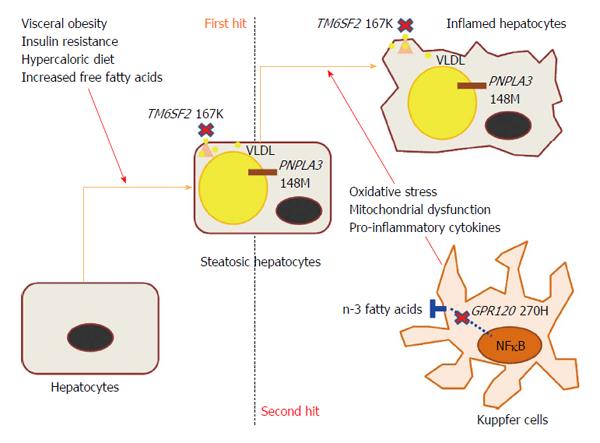Copyright
©The Author(s) 2015.
World J Hepatol. Jun 18, 2015; 7(11): 1439-1443
Published online Jun 18, 2015. doi: 10.4254/wjh.v7.i11.1439
Published online Jun 18, 2015. doi: 10.4254/wjh.v7.i11.1439
Figure 1 The updated “two hits hypothesis”.
The hyperinsulinemia and insulin resistance, accompanying obesity, lead to liver steatosis increasing the absolute non esterified fatty acids uptake in the liver and the esterification to form triacylglycerol. The PNPLA3 148M allele encodes for an abnormal protein and predisposes to intrahepatic triglycerides accumulation by both a reduced effect on triglycerides hydrolysis and an enhanced lipogenetic effect. Therefore, it is involved in the first hit. Also the TM6SF2 E167K polymorphism plays a role in the first hit, in fact, it lead to intrahepatic fat accumulation through a reduced VLDL secretion. The oxidative stress is involved in the second hit leading to the progression to NASH because of its harmful action on steatosic hepatocytes. Reactive oxygen species can induce hepatocellular injury and then fibrosis through the inhibition of the mitochondrial respiratory chain enzymes, lipid peroxidation, cytokine production, Fas Ligand induction. The GPR120 270H allele, reducing the anti-inflammatory action of the GPR120 receptor expressed by Kuppfer cells, is involved in the second hit promoting the oxidative stress, mitochondrial dysfunction and pro-inflammatory cytokines release. PNPLA3: Patatin like phospholipase containing domain 3 gene; NASH: Nonalcoholic steatohepatitis; GPR120: G-protein-coupled-receptor 120; TM6SF2: Transmembrane 6 superfamily member 2 gene; NFκB: Nuclear factor-kappa-B; VLDL: Very low density lipoprotein.
- Citation: Marzuillo P, Grandone A, Perrone L, Miraglia del Giudice E. Understanding the pathophysiological mechanisms in the pediatric non-alcoholic fatty liver disease: The role of genetics. World J Hepatol 2015; 7(11): 1439-1443
- URL: https://www.wjgnet.com/1948-5182/full/v7/i11/1439.htm
- DOI: https://dx.doi.org/10.4254/wjh.v7.i11.1439









